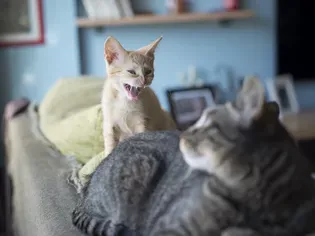How to Solve Aggression Between Household Cats
Updated on 04/26/24

Unveiling the Secrets to Resolving Aggression Between Beloved House Cats
Cats, known for their independent and aloof nature, can occasionally exhibit aggression towards other household feline companions. This seemingly inexplicable behavior can be a source of distress for pet owners, leading to a disrupted home environment and concerns for the well-being of their furry friends. However, understanding the underlying causes and implementing effective strategies can restore harmony and prevent future conflicts.
Deciphering the Roots of Cat Aggression
Recognizing the triggers that ignite aggression is paramount in finding a solution. Cats may become aggressive due to:
* Territorial disputes: Cats have a strong sense of territory and can view other cats as a threat to their domain.
* Resource competition: Competition over food, water, or litter boxes can lead to tension and aggression.
* Fear or anxiety: Cats can become aggressive if they feel threatened or stressed by another cat's presence.
* Medical conditions: Underlying medical conditions, such as pain or illness, can cause irritability and aggression.
* Past experiences: Negative experiences with other cats in the past can create a predisposition to aggression.
Step-by-Step Guide to Diffusing Aggression
Once the underlying cause has been identified, a multi-pronged approach is crucial to resolve aggression and foster a peaceful coexistence:
1. Separate the Cats:
The initial step is to physically separate the cats to prevent further conflict. Provide each cat with its own designated space, including a food and water bowl, litter box, and sleeping area.
2. Gradual Reintroduction:
After a period of separation, gradually reintroduce the cats under controlled conditions. Allow them to interact for brief periods under supervision. Start by using a baby gate or keeping them in separate rooms with close proximity. Gradually increase the duration and intensity of their interactions as they become more comfortable.
3. Environmental Management:
Create a cat-friendly environment that minimizes triggers for aggression. Ensure there are ample resources, such as food and water bowls, litter boxes, and scratching posts, to prevent competition. Provide vertical space, such as cat trees or shelves, to allow cats to escape and observe their surroundings from a safe distance.
4. Behavior Modification Techniques:
* Positive reinforcement: Reward cats for calm and friendly behavior towards each other. Provide treats, playtime, or affection when they interact positively.
* Negative reinforcement: Avoid punishing cats for aggressive behavior. Instead, redirect their attention to more acceptable behaviors and reward them for compliance.
* Feliway diffusers: These diffusers release synthetic pheromones that create a calming effect and reduce anxiety in cats.
5. Desensitization and Counter-Conditioning:
Help cats overcome their negative associations with each other by gradually exposing them to the presence of the other cat in a non-threatening way. Start at a distance where they don't react aggressively, and gradually decrease the distance while reinforcing positive behaviors.
6. Veterinary Examination:
If aggression persists despite implementing the above strategies, consult a veterinarian to rule out any underlying medical conditions that may be contributing to the problem.
Success Stories of Aggression Resolution
Example 1:
Bella and Max, two adult cats, constantly fought over food and territory. After separating them and gradually reintroducing them with positive reinforcement, they learned to share resources and coexist peacefully.
Example 2:
Oliver, a shy cat, became aggressive towards his new feline roommate, Shadow. Using Feliway diffusers and desensitization techniques, Oliver gradually adapted to the presence of Shadow and now enjoys playing with him.
Conclusion
Resolving aggression between household cats requires patience, understanding, and a comprehensive approach. By identifying the underlying causes, implementing behavior modification techniques, and creating a positive environment, pet owners can restore harmony and create a peaceful coexistence for their beloved furry companions. Remember that every cat is unique, and customized strategies may be necessary to find what works best for each individual situation.
Explore More Pets

Cat Behavior Problems
How to Stop Aggression in Kittens

Long-Haired Cat Breeds
Siberian Cat: Breed Profile, Characteristics, & Care

Cat Behavior Problems
How to Stop Kittens From Scratching and Biting

Long-Haired Cat Breeds
Turkish Angora: Cat Breed Profile, Characteristics & Care

Basic Training
How to Socialize Your Kitten

Short-Haired Cat Breeds
Cute Pictures & Facts About Calico Cats & Kittens

Litter Box Training
Training Your Kitten to Use the Litter Box

Long-Haired Cat Breeds
10 Fun Facts About White Cats